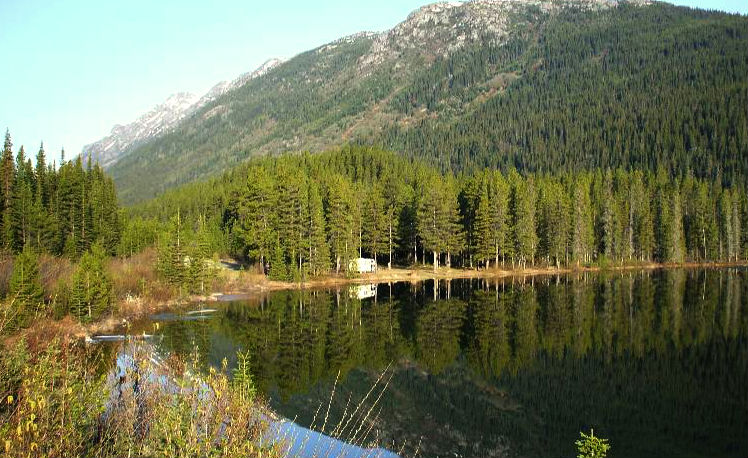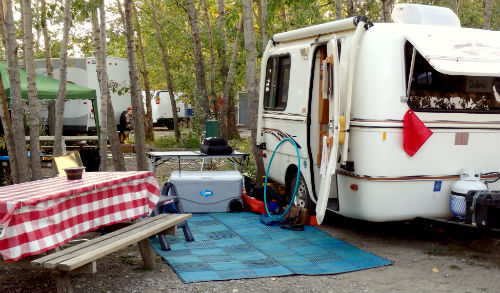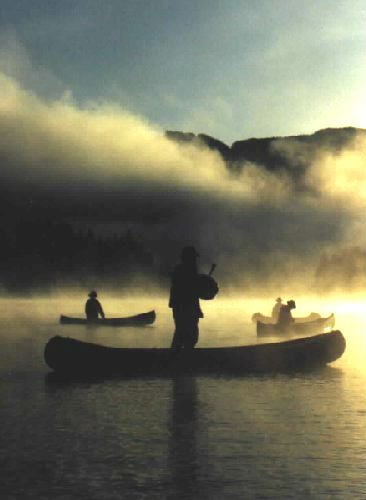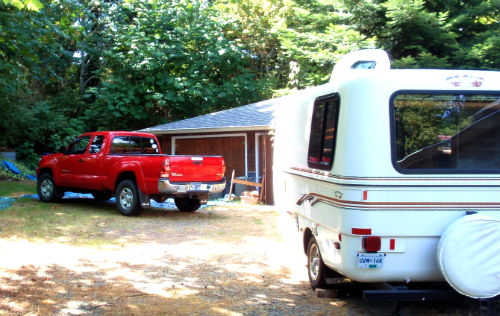Western Canada and Alaska is a calling for many RVers. They are destinations unlike any other and attract thousands of RVers every year. Planning is always considered the most exciting part of any trip. But when driving to Alaska through British Columbia and the Yukon, it’s the most important part of the trip.

Barbara Dobree, 70, of Comox, British Columbia, went on the journey towing a 13-foot, fiberglass 2004 Trillium trailer with a 2006 Toyota Tacoma 4×4. Photo courtesy of Waiter21, iRV2.com member
“There are some people that like to wing it, but I strongly suggest preparing for a trip like this,” says Barbara Dobree, an avid RVer who completed a 12,500-kilomter round trip from Vancouver Island, British Columbia, to the Yukon, Alaska, Northwest Territories and Alberta in July 2016. “It took about a year to properly plan, but during my travels I had very few problems.”

Dobree’s rig and campsite during her journey. Photo by Barbara Dobree
Dobree, 70, of Comox, British Columbia, went on the journey with her partner towing a 13-foot, fibreglass Trillium trailer with a Toyota Tacoma 4×4. Never one to leave anything to chance, the former university educator spent the better part of a year addressing trailer and tow vehicle preventive maintenance issues to ensure a smooth three-month journey. After all, Dobree`s travels led her to such routes as the Alaskan Highway, as well as the Dempster Highway, which connects the Klondike Highway in the Yukon to Inuvik, Northwest Territories, on the Mackenzie River Delta.
Additionally, Dobree told RVlife.com she had hoses, belts, spark plugs, and four tires replaced. She also brought along extra spare tires and fuel. Dobree`s trailer, too, went through a minor makeover to ensure the propane was running properly, leaks to roof vents and windows were repaired, tires replaced, and the wheel bearings re-packed.

There are many scenic places to explore all throughout these regions. Photo by Barbara Dobree
“I heard horror stories about the Dempster with RVers blowing tires. I didn’t blow any, but I saw people that did,” says Dobree. “The trailer is in good condition but some repairs were in order. Also, a lot of service was done to my tow vehicle.”
While visiting many scenic regions such as Fort St. James, Atlin and the Nass River Valley in British Columbia; Whitehorse and Dawson City in the Yukon; Skagway in Alaska; plus Fort MacPherson and Inuvik in the Northwest Territories, Dobree suggests RVers need to establish their own list of priorities and essentials. These are a few of ideas to consider:
- Research. Decide where and when you want to go and determine the best time of year to visit. Then, plan the safest route. Research every highway and note services along the way. Keep in mind that routes like the Dempster Highway only has one gas station in approximately 400-plus miles. Also, weather conditions vary drastically day to day.
- Buy a 12V air compressor. Flat tires occur when you least expect it. A portable air compressor or even a tire repair kit may just get you to the next service center.
- Use Solar Power. Dry, rustic camping in these regions is common and there are many solar power systems available for your needs.
- Buy a Pop Up Screen. This was a lifesaver for Dobree. Bugs are everywhere in the summer months so be sure to protect yourself (and save your sanity).
- Bring Back up parts. Carry extra fuel, important parts, and two spare tires for both vehicles.
- Plan Safely. Gain a peaceful mind when navigating with the use of RV trip planning apps.
“Getting my truck and trailer in order was the best thing I did,” says Dobree. “Additionally, research was essential. I made a point to see the attractions I may never see again. That was important to me. ”

Make it a priority to prearrange campgrounds. Photo by Barbara Dobree
Plan Your Campgrounds when Traveling Western Canada and Alaska
“We camped 91 nights and half of those were free through the use of the BC Recreation Sites and Trails,” says Dobree. “I did a lot of research on those. The majority of these sites were on a lake or river and were just gorgeous. All had picnic tables and an outhouse. But the great thing is the fact that nobody is there, except for maybe the odd fisherman in the evening.”
For some, a journey this extensive may be nerve-racking. Yet, as Dobree explains , pursue your goals and if you properly prepare, it will go smoothly.
“I suggest going despite any apprehension,” explains Dobree. “The Alaska Highway is so much better than what it used to be. We took our time and the trip just blew me away. But to avoid problems, I really recommend proper preparation no matter what type of camping you enjoy.”

It would be a trip of a lifetime for us, and one I do want to make, but what is your knowledge of how big rig Class A’s have managed along these routes, especially the one highway with only one filling station in 500 miles? How do the big rigs, who might two a small car or jeep (as we do) behind for local transportation; how do they pack along extra tires for their rigs, considering the RV tires are HUGE! Extra fuel? It sounds like I would have to drop my towed vehicle and tow an extra trailer, just for all the extra provisions and supplies! Doesn’t sound profitable to me.
We went in Autumn 2008, in a 30′ Tioga (a budget-level class C), towing a Jeep Liberty. We drove the Dempster to the first ferry (50 miles short of Inuvik?), but turned around there because the ferry operators had not properly graded the far bank, and as we watched nearly ripped the rear bumper off an RV coming the other direction.
We took 2 spares (one unmounted) for the RV, and one for the Jeep. The Dempster was reasonably well maintained and not (to my mind) particularly hazardous to tires. Portions, however, were washboarded, so we drove substantial sections at around 15 mph. We will probably NOT bother to take a 2nd spare next time — if it’s really necessary we can use one vehicle to ferry a tire for the other to somewhere that can service or replace it. I would be reluctant to go without a full size spare for each vehicle, though.
There is no cell service along most of the Dempster. We carry an InReach satellite messaging device, so can arrange emergency assistance if truly necessary.
The Dempster was the highlight of our trip. Much of the route is north of the treeline, so you can see for miles in all directions. The tundra was in full fall color when we went, and absolutely gorgeous.
We should, however, have slowed down a bit more. We broke the joint between cab and cab-over, which was held together by 17 aluminum rivets. All 17 were sheared off by the bouncing of the washboarded sections. This joint is now secured by at least 30 steel rivets, with through-bolts in each one to further strengthen them, so is probably at least 10 times as strong as when new. I don’t expect a decent class A would have any similar issue.
So the Dempster broke our rig — but it was WORTH IT, and I’ll likely do it again. Hopefully next time we’ll be able to cross on the ferries, and the Dempster extension construction currently in progress will be finished …
We drove partway out the haul road as well, but turned around at the arctic circle — there were simply too many bugs, far more than we’d seen on the Dempster just a week or two earlier. If you have to make a choice between the two, I’d strongly recommend the Dempster.
We didn’t much like Skagway (too touristy), but loved the highway to there through the Tormented Valley.
We loved Hanes — it seems quintessential small town Alaska — but there’s nothing particularly special about the highway to there. Where else could you possibly find, essentially across the street from each other, museums concentrating on subjects as diverse as native americans and hammers?
If you like museums, the Museum of the North in Fairbanks is the best in AK — well worth a day or more of your time.
Hi John,
Thanks very much for your insight and sorry to hear about your rig.